Wacom DTK-2200 User Manual

Contents Index
1
User’s manual
Cintiq 22HD
Setting up
Using the display stand
Using the pen
Customizing the pen
Using the pen display
Customizing the pen display
Using the Radial Menu
Application-specific settings
FAQs
Troubleshooting
Contents Index
1

Contents Index
2
Cintiq 22HD
User’s Manual
Version 1.0, Rev C0612
Copyright © Wacom Co., Ltd., 2012
All rights reserved. No part of this manual may be reproduced except for your express personal use. Wacom reserves the right to revise this publication without obligation to provide notification of such changes.
Wacom does its best to provide current and accurate information in this manual. However, Wacom reserves the right to change any specifications and product configurations at its discretion, without prior notice and without obligation to include such changes in this manual.
The above year indicates when this manual was prepared. However, the date of release to the users of the “manual” is simultaneous with the introduction into the market of the applicable Wacom product.
Cintiq and Wacom are registered trademarks of Wacom Co., Ltd.
Adobe and Photoshop are either registered trademarks or trademarks of Adobe Systems Incorporated in the United States and/or other countries. Microsoft, Windows, and Vista are either registered trademarks or trademarks of Microsoft Corporation in the United States and/or other countries. Apple, the Apple logo, and Mac are trademarks of Apple, Inc., registered in the U.S. and other countries.
Any additional company and product names mentioned in this documentation may be trademarked and/or registered as trademarks. Mention of third-party products is for informational purposes only and constitutes neither an endorsement nor a recommendation. Wacom assumes no responsibility with regard to the performance or use of these products.
ExpressKey is a registered trademark of Ginsan Industries, Inc., and is used with permission.
Front cover image courtesy of www.daniellieske.com
Contents Index
2

Contents Index
3
TABLE OF CONTENTS
About the manual
UNPACKING YOUR CINTIQ
USING THE CINTIQ DISPLAY STAND Display stand features
Display stand location
Mounting Cintiq on the display stand Adjusting the display incline Adjusting rotation
Removing Cintiq from the display stand
SETTING UP YOUR CINTIQ
System requirements
Step 1: Hardware installation
Step 2: Software installation
GETTING TO KNOW YOUR CINTIQ Pen display features
Front view Rear view Pen features
WORKING WITH YOUR CINTIQ Setting up your work area Configuring Cintiq for handedness Using the Grip Pen
Holding the pen Positioning Clicking Dragging
Using the side switch
Working with pressure sensitivity Drawing with tilt
Erasing
5 |
Pen display controls |
29 |
|
6 |
Using the hardware control buttons |
30 |
|
Using the ExpressKeys |
31 |
||
7 |
|||
Using the Touch Strips |
33 |
||
8 |
|||
Working with multiple monitors |
35 |
||
9 |
|||
Adjusting the display |
36 |
||
10 |
|||
Factory presets, auto-sync, and user settings |
36 |
||
11 |
|||
On Screen Display (OSD) settings |
37 |
||
11 |
|||
Power saving |
39 |
||
12 |
|||
CUSTOMIZING YOUR CINTIQ |
40 |
||
13 |
|||
Manage your control panel settings |
41 |
||
13 |
|||
Control panel overview |
42 |
||
14 |
|||
Calibrating the pen display |
44 |
||
17 |
|||
Customizing the pen |
45 |
||
|
|||
18 |
Adjusting tip feel and double-click |
46 |
|
18 |
Adjusting eraser feel |
47 |
|
19 |
Advanced tip and eraser pressure settings |
47 |
|
20 |
Customizing tool buttons |
48 |
|
21 |
Customizing tilt sensitivity |
49 |
|
22 |
Customizing pen display functions |
49 |
|
Customizing the ExpressKeys |
50 |
||
22 |
|||
Customizing the Touch Strips |
51 |
||
24 |
|||
Button functions |
52 |
||
24 |
|||
Using and customizing the Radial Menu |
59 |
||
25 |
|||
Working with Display Toggle |
60 |
||
26 |
|||
Application-specific settings |
61 |
||
26 |
|||
Creating an application-specific setting |
62 |
||
27 |
|||
Changing application-specific settings |
63 |
||
27 |
|||
Removing application-specific settings |
63 |
||
27 |
|||
Working with multiple tools |
64 |
||
28 |
|||
Renaming the tablet in the tablet list |
65 |
||
28 |
|||
|
|
Contents Index
3

Contents Index
TROUBLESHOOTING |
66 |
Testing Cintiq |
67 |
Testing controls and input tools |
69 |
Testing the hardware control buttons |
70 |
Testing the ExpressKeys |
70 |
Testing the Touch Strips |
70 |
Testing a pen |
71 |
Display troubleshooting |
72 |
General display problems |
72 |
VGA problems |
74 |
Pen tablet troubleshooting |
75 |
General problems |
75 |
Windows-specific problems |
79 |
Mac-specific problems |
80 |
Technical support options |
82 |
Obtaining software updates |
83 |
FREQUENTLY ASKED QUESTIONS |
84 |
CARE AND MAINTENANCE |
86 |
Caring for Cintiq |
86 |
Replacing the pen nib |
87 |
Contents Index
|
4 |
OTHER USEFUL INFORMATION |
89 |
Optional display configurations |
90 |
Using an alternate mount or stand |
91 |
Cable removal and replacement |
94 |
Uninstalling Cintiq |
96 |
Using the Express View display |
97 |
Managing preferences |
98 |
Installing multiple tablets |
99 |
Using applications integrated for tablet control |
100 |
Importing expert settings |
101 |
Pen and digital ink capabilities in Windows |
102 |
Product information |
103 |
Ordering parts and accessories |
104 |
Available parts and accessories |
104 |
GLOSSARY |
105 |
INDEX |
108 |
4
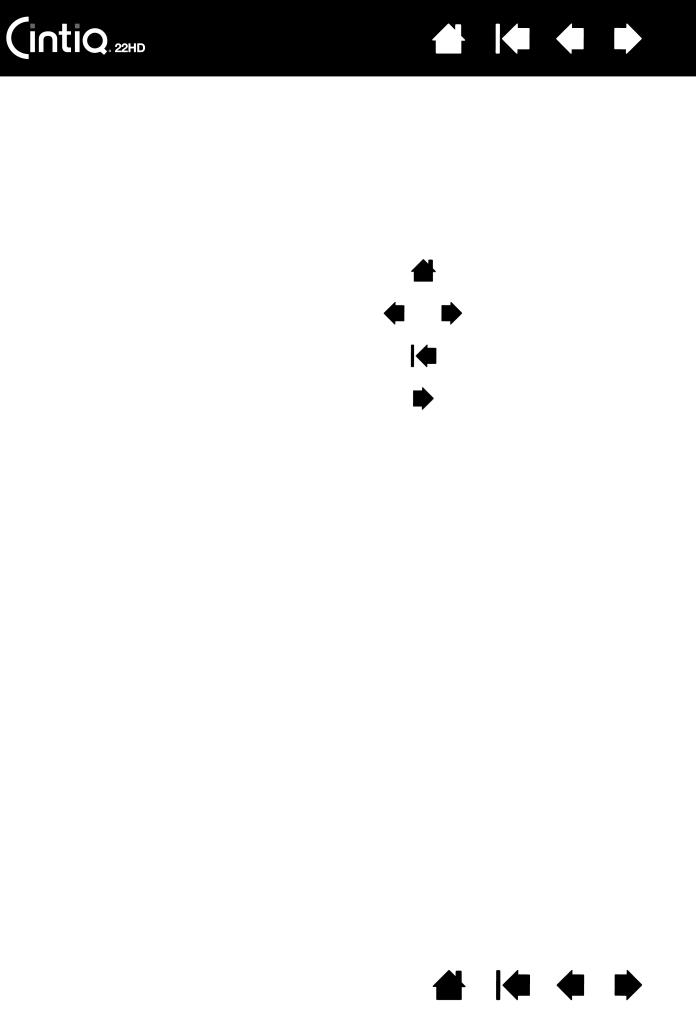
Contents Index
5
ABOUT THE MANUAL
This manual provides quick access to information about your Cintiq. The information is common to Windows and Mac computers. Windows screen captures are shown unless otherwise noted.
•Go directly to table of contents or index topics by clicking on them.
•Use the navigation controls to move through the manual.
|
|
Go to front page. |
Contents |
Go to table of contents. |
Page back, or page forward. |
Index |
Go to index. |
Go back to previous view. |
topic |
Go to topic. |
Topic continued. |
•Use your .pdf viewer zoom-in tool to increase the size of the manual on your display screen. See the viewer application help for information on any additional tools that help you use and print the manual.
•SMALL CAPITAL LETTERS are used to identify the names of keyboard keys, dialog boxes, and control panel options.
•Be sure to see also the Important Product Information guide for Cintiq, located on the Installation CD. The guide includes product safety precautions, specifications, and your license agreement.
•The following information is not included with this product: information about your specific computer hardware or operating system, or information about your application software. Your best source for this information is the set of manuals and discs that came with your hardware, operating system, or application.
Wacom’s philosophy is to continually improve all of its products. As a result, engineering changes and improvements are made from time to time. Therefore, some changes, modifications, and improvements may not be covered in this manual.
Contents Index
5

Contents Index
6
UNPACKING YOUR CINTIQ
Your Cintiq 22HD interactive pen display comes with the Cintiq display stand and a variety of accessory parts. The product parts and accessories are packed together in the accessories box. To avoid damage, see the instructions on the following pages before setting up and using Cintiq or the Cintiq stand.
Carefully unpack and place all items on a stable surface. Save the packing materials and package box for use when shipping or storing Cintiq.
•Remove any packing materials from the back of the pen display and cabling.
•After unpacking, inventory and ensure the box contents are complete.
Cintiq interactive pen display
Installation CD
Includes the software driver and Important Product Information guide.
Quick Start Guide
Rotation lock screws, qty 2
Grip, wide-bodied
Pen, with personalization rings
To personalize, unscrew the tip cone and replace the ring with a different color.
Pen stand,
includes replacement nibs and nib extraction tool
Warranty card included with some configurations.
Patented Cintiq display stand
See display stand features.
AC power adapter and cable
Some configurations do not include all shown items. Check the product listing.
Note: Some configurations may include additional CDs or DVDs containing application software. To install, see the instructions for those CDs or DVDs.
Before installing, take some time to learn about your Cintiq interactive pen display and Cintiq display stand.
Contents Index
6
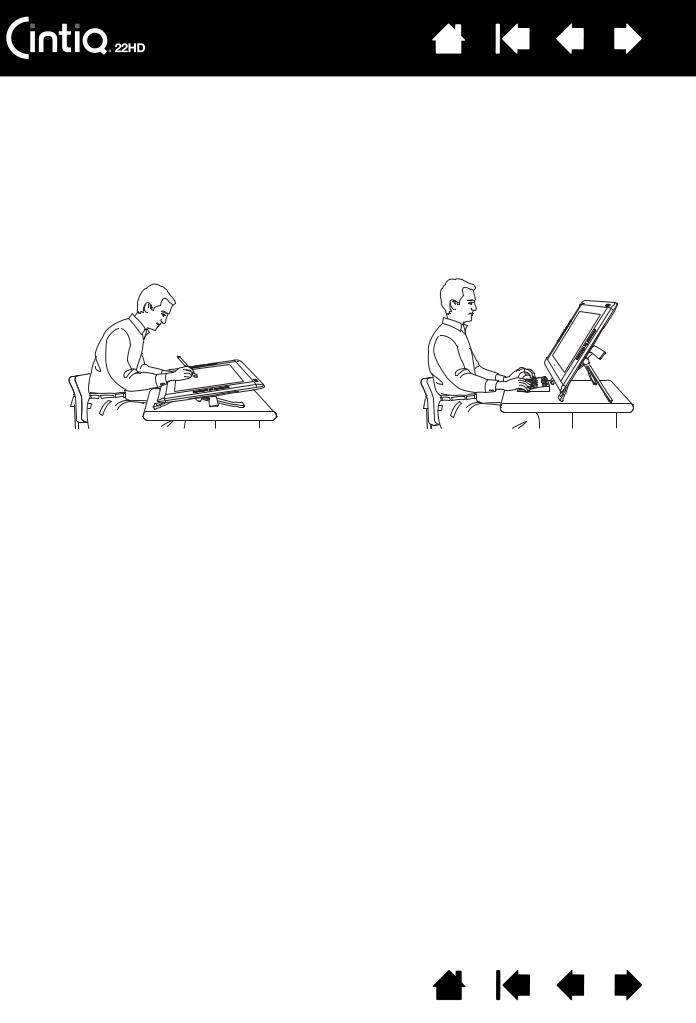
Contents Index
7
USING THE CINTIQ DISPLAY STAND
The Cintiq display stand is designed to support the weight of your Cintiq interactive pen display.
•Cintiq can accommodate a variety of uses and working styles. Use the stand to adjust the working position of Cintiq so as to best meet your needs throughout the day.
•You can move or slide Cintiq to different locations on your desktop. Remember that you may need to adjust the incline to which you have positioned Cintiq before moving the pen display.
Adjust the display stand to a lower position as needed to emulate an easel, animator’s table, or drafting table.
At the lowest position of the stand, Cintiq can be freely rotated to any angle without touching the desktop for the greatest comfort and accuracy of stroke while drawing or editing images.
Adjust the stand to a more vertical position when a large amount of keyboard input is required. This position is also useful when presenting your work to co-workers or clients.
Display stand features Display stand location
Mounting Cintiq on the display stand Adjusting the display incline Adjusting rotation
Removing Cintiq from the display stand
Contents Index
7
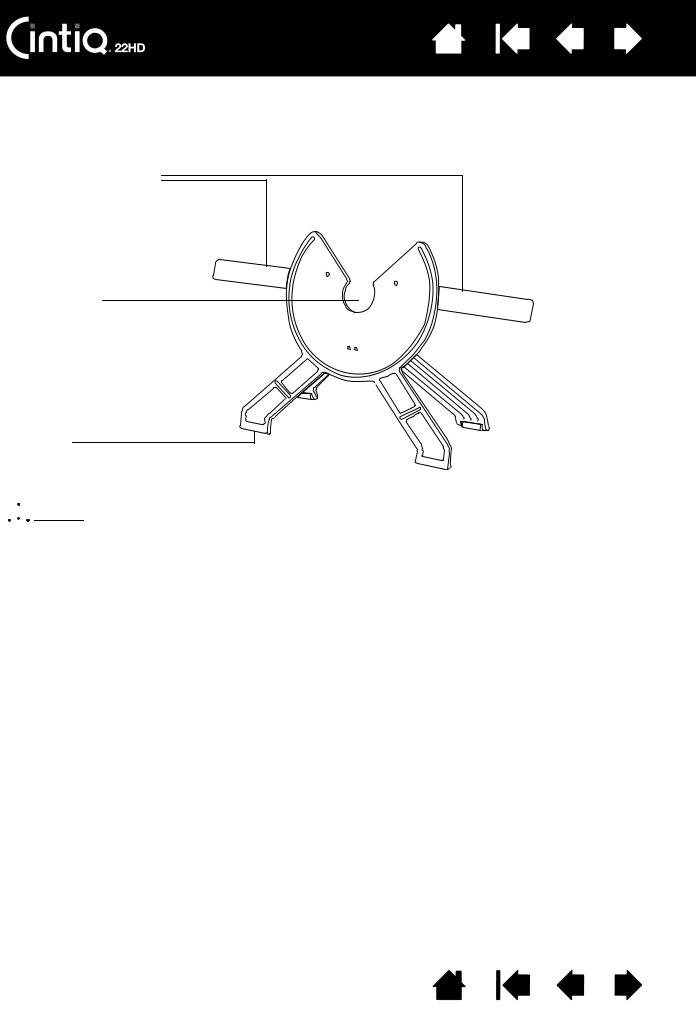
Contents Index
8
DISPLAY STAND FEATURES
Place the Cintiq display stand on your desktop or other stable work surface. Select a level location where the stand is stable and will not tip or fall when the pen display is mounted on it. Take some time to familiarize yourself with the display stand components.
Incline adjustment levers
When Cintiq is mounted on the stand, use these levers to adjust the display incline. See adjusting the display incline.
Bearing recess
Front feet
The front feet have rubber pads to reduce slippage on the desktop.
 Warning
Warning
 Rear feet
Rear feet
The rear feet are on rollers, allowing them to move when adjusting incline.
Do not operate the incline adjustment levers when Cintiq is not mounted on the stand, and do not lift the stand by the adjustment levers. The stand is spring-loaded and may cause injury or damage if released without the weight of Cintiq on the stand. Improper operation may lead to physical injury or damage to the stand. Be careful to avoid catching your finger in the gap of the movable portion of the stand.
Do not place on any unsteady surface or table. Do not place on slanted areas, unstable areas, or areas where vibration is present. Physical damage or personal injury may result if this product falls from an unsuitable surface.
Next: Mount the Cintiq interactive pen display on the Cintiq stand. See mounting Cintiq on the display stand.
Contents Index
8

Contents Index
9
DISPLAY STAND LOCATION
Select a location on your desktop or other work surface that is level and stable.
•Choose a location on a desktop or other working surface that is flat, clean, and free of any moisture or oily film.
•Make sure the Cintiq display stand is placed in a stable position on your desktop or other work surface so that it will not tip or fall when Cintiq is mounted on it.
 Warning
Warning
Place Cintiq securely on a level, stable desktop or other working surface.
Do not place this product on any unsteady surface or table. Do not place on slanted areas, unstable areas, or areas where vibration is present. Physical damage or personal injury may result if this product falls from an unsuitable surface.
Do not place this product on any wet surface or table. Doing so may cause the this product to slip, allowing the product to fall.
Contents Index
9
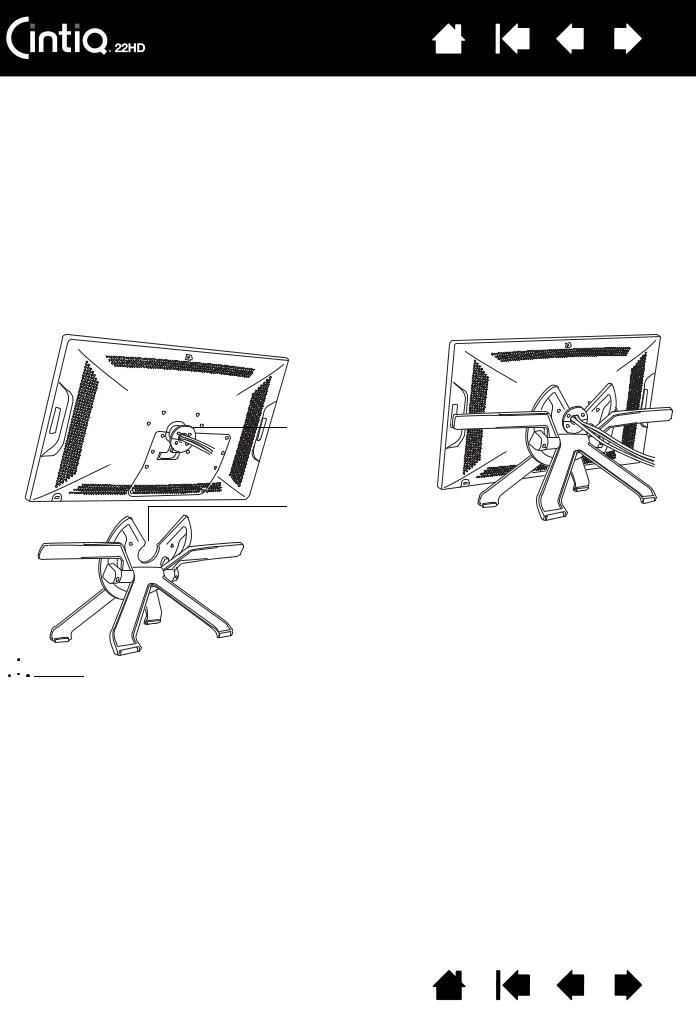
Contents Index
10
MOUNTING CINTIQ ON THE DISPLAY STAND
Before mounting Cintiq on the stand for the first time, remove any packing materials from the back of the pen display and cabling.
•Make sure the stand is placed in a stable position on your desktop or other work surface so that it will not tip or fall when Cintiq is mounted on it. Securely grasp Cintiq with both hands. The display should face toward you, with the power button on top and status LEDs located to the upper left.
•Align Cintiq parallel to the front of the display stand so the bearing hub is located between the V-shaped upper edges of the bearing recess. The V-shaped edges will serve as a guide for positioning the bearing hub. See – A – below.
•With the back of Cintiq resting against the stand, lower Cintiq until the bearing hub rests securely in the bearing recess. The pen display will be held in place by gravity. There will be no audible ‘snap’ to indicate a mechanical lock. See – B – below.
– A – |
– B – |
Bearing hub
Bearing recess
After mounting the pen display on the stand, remove the foam blocks that lock the adjustment levers in place. Save these blocks with the other packaging materials. You will need them if in the future you want to ship Cintiq.
 Warning
Warning
When operating the incline adjustment levers, Cintiq must be mounted on the stand with the stand feet resting on a stable, flat surface. The stand is spring-loaded and can snap back quickly, causing injury or damage if not operated properly.
•Check for stability of the display stand. Carefully move the pen display and stand through their full range of motion. See adjusting the display incline.
•If you do not need to rotate the Cintiq pen display, you can secure it to the stand with the rotation lock screws. See optional display configurations.
To learn about other mounting options, see using an alternate mount or stand.
Contents Index
10
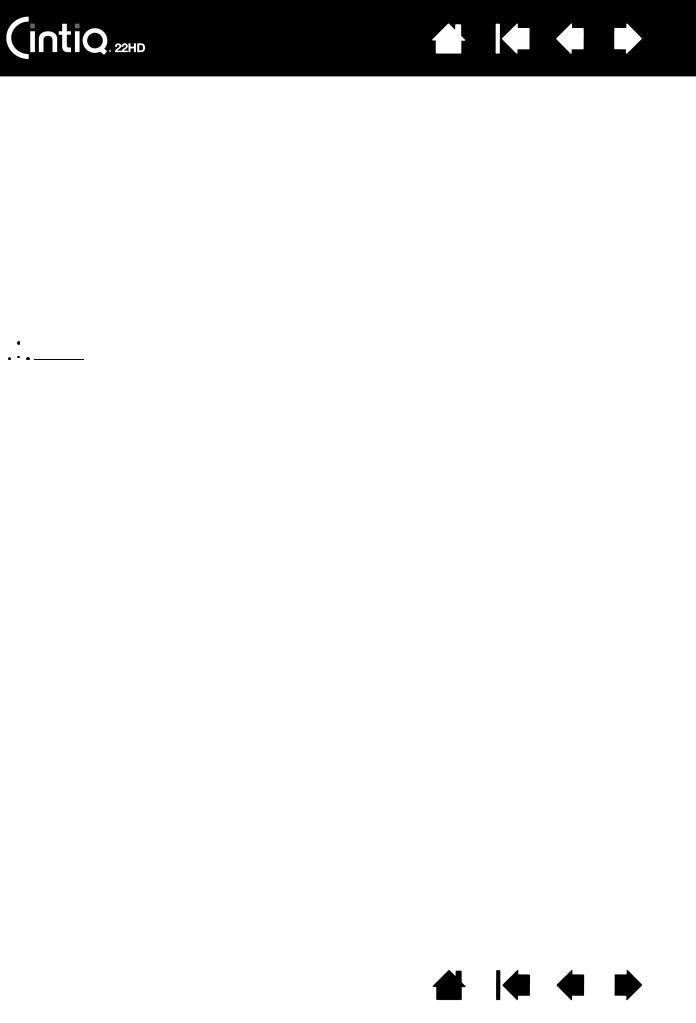
Contents Index
11
ADJUSTING THE DISPLAY INCLINE
You can adjust the pen display height and incline to best meet your needs throughout the day.
To change the display incline or viewing angle, face the front of the pen display and grasp it on the left and right side at approximately the same height as the display stand adjustment levers. Use your fingertips to gently pull the incline adjustment levers toward the pen display. This will release a clutch mechanism.
Tilt the display to adjust the incline setting.
•To lower Cintiq, pull the left incline adjustment lever toward Cintiq and gently lower Cintiq to the desired incline angle. Release the lever to lock the stand in place.
•To raise Cintiq, pull the right incline adjustment lever toward Cintiq and gently raise Cintiq to the desired incline angle. Release the lever to lock the stand in place.
Note: The incline adjustment levers exhibit some natural play before the clutch mechanism engages. When adjusting incline, set the display stand to an incline slightly higher than you plan to work with, then lower the display to the desired position.
 Warning
Warning
Before moving Cintiq, first adjust the stand to its full upright position. This will reduce the spring tension so the stand will not accidentally release and snap shut. If the pen display is in landscape orientation, use one hand to grasp the bottom of the display and with your other hand grasp the back of the stand. Be sure to lift on both the display and the stand so the stand will not separate from the display when moving Cintiq.
If Cintiq is in portrait orientation or has been locked to the stand with the rotation lock screws, the stand will not separate from the pen display and Cintiq can be safely lifted by grasping the display with both hands. See optional display configurations.
Next: Familiarize yourself with the pen display. See getting to know your Cintiq.
ADJUSTING ROTATION
To adjust rotation, grasp Cintiq by the main body and rotate the pen display to the desired position. It will move on the bearing hub.
Cintiq can be rotated on the display stand when the incline is less than or equal to 25 degrees. You can only rotate the pen display 180 degrees in either direction.
If you do not plan to rotate the pen display, use the rotation lock screws and fasten the display to the stand in a horizontal position. See optional display configurations.
Contents Index
11
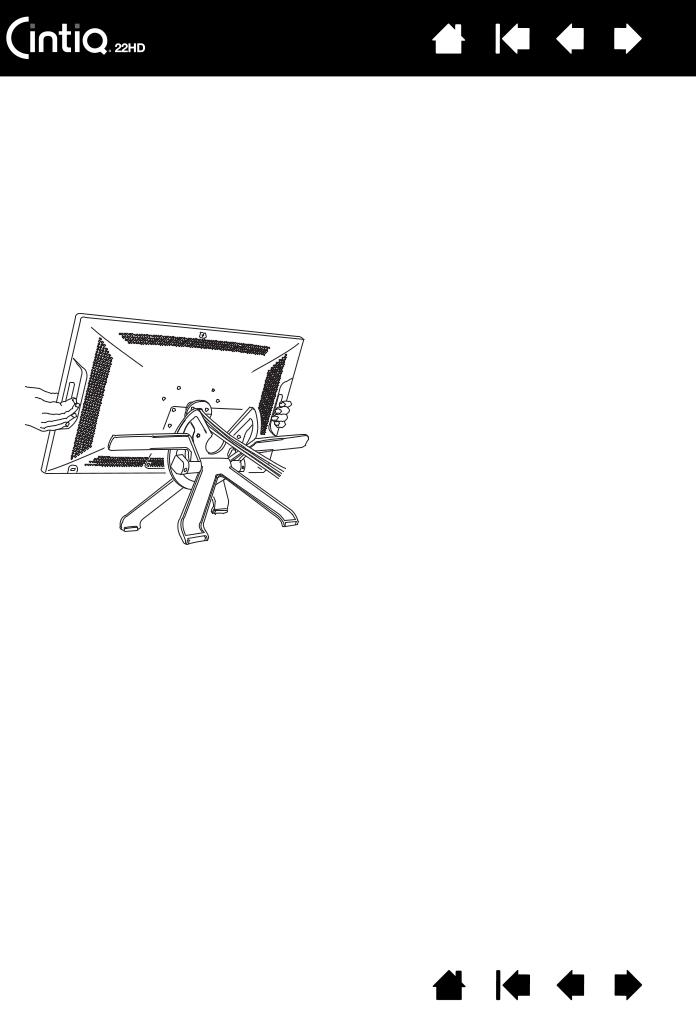
Contents Index
12
REMOVING CINTIQ FROM THE DISPLAY STAND
The Cintiq interactive pen display has been specifically designed for use when mounted on the Cintiq display stand. However, there may be times when it will be necessary to remove the pen display from the stand. For example, you may want to locate the pen display on a suitable VESA mounting arm.
See using an alternate mount or stand.
To remove Cintiq from the display stand:
•If the rotation lock screws are attached, remove them from the back of Cintiq.
•Position the pen display to landscape orientation before removing it from the display stand. The stand will not release unless Cintiq is in landscape orientation.
•Next, raise the stand incline to the highest position. See adjusting the display incline.
•Firmly grasp the pen display on both the left and right sides, and lift out of the display stand.
Important: When removing Cintiq from the display stand, always lift Cintiq in a direction parallel to the front of the stand. You may also need to slightly rotate Cintiq so the stand will release.
Note: When packing Cintiq for transport, first adjust the stand to its lowest position and place the foam packing blocks under the incline adjustment levers before removing Cintiq from the stand. The foam blocks will keep the stand from snapping shut while in its packaging. Always pack Cintiq and its stand in their original containers and protective cushions. Never pack Cintiq while it is mounted on the stand. Doing so may damage the pen display or stand during transport.
Contents Index
12

Contents Index
13
SETTING UP YOUR CINTIQ
Your Cintiq 22HD interactive pen display functions as both a display and a pen tablet. Follow the instructions below to complete the hardware and software installation.
Important: You MUST install the Wacom driver software for correct pen-on-screen functionality.
System requirements
Step 1: Hardware installation
Step 2: Software installation
SYSTEM REQUIREMENTS
Make sure your computer meets the following minimum system requirements:
•PC. Windows 7, Vista (SP2 or later), XP (SP3 or later). 32 or 64-bit configurations. DVI or VGA port. Available USB port and CD-ROM drive.
•Mac. OS X, v10.5.8 or later. Intel-based platforms only are supported. DVI or VGA port, or appropriate Mini DisplayPort to DVI adapter. Available USB port and CD-ROM drive.
Cintiq supports digital (DVI) and analog (VGA) video signals. For optimum performance, connect Cintiq to a digital video card.
VGA connection is not recommended as the display quality will not be as good as with a digital connection. VGA connection requires that you obtain an appropriate DVI-I to VGA adapter cable. Check with your local product retailer or an online outlet.
Notes:
Cintiq can be used alone or with another display, such as a CRT monitor or LCD projector. To use Cintiq with another display, you will need two video cards or a video card with dual output.
You may be able to set up Cintiq as a mirrored, extended, or independent display. When working with more than one monitor, Cintiq will map to the monitors based upon how your system is configured. By default, if you are in mirror mode, the pen display will map to the entire space on each monitor. See your hardware and operating system documentation for details on configuring your system for use with multiple monitors.
A Display Toggle function is available for use with multiple display systems. This enables you to toggle the screen cursor between Cintiq and your other displays.
Contents Index
13
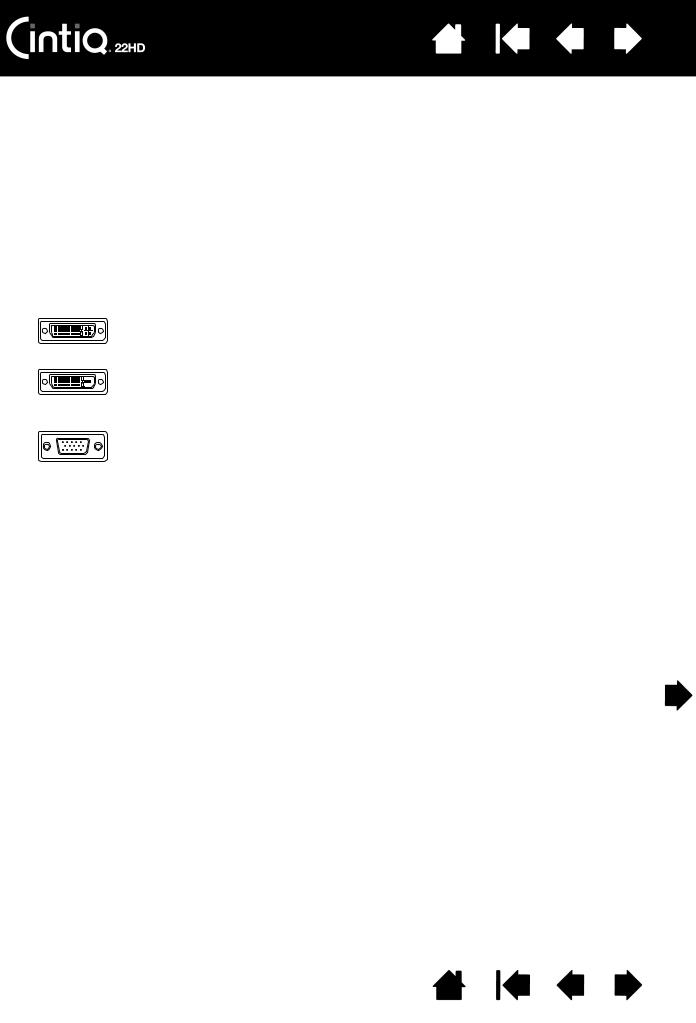
Contents Index
14
STEP 1: HARDWARE INSTALLATION
In this step, connect the video, USB, and power cables.
If you have not already done so, mount Cintiq on the display stand.
Important: Never connect or disconnect the video or power cables while your computer or pen display are powered on. This can damage the display or video card.
1.Turn off your computer.
2.Determine if your computer has a digital (DVI) or analog (VGA) port. If your computer has only one video port, unplug your previous monitor or add a second video card. For best results, connect Cintiq to a DVI-D or DVI-I card.
3.Follow the below instructions for your video port. Make sure to tighten any connector thumbscrews. See – A – in the connection diagram.
DVI-I
DVI-D
VGA
For DVI operation, connect the Cintiq video cable to the DVI port located on your computer video card.
The Cintiq video cable has a DVI-D connector. Cintiq can be connected to either a DVI-D or a DVI-I card.
For VGA operation, you will need to obtain a Wacom accessory DVI-I to VGA adapter cable. See ordering parts and accessories.
Remove the DVI-D cable from Cintiq and replace it with a DVI-I to VGA adapter cable. See cable removal and replacement. Connect the adapter cable between the Cintiq and your video card.
If connecting to a Mac Mini DisplayPort, you will need to obtain an appropriate active adapter cable, such as those offered by Kanex, Apple, or other manufacturers. Check with your local product retailer or an online outlet for availability.
Connect the adapter between the DVI-D end of the Cintiq video cable and your Mac.
4.Plug the USB connector into an available USB port on your computer or USB hub attached to your computer. See – B – in the connection diagram.
5.Connect the power adapter to Cintiq. See – C – in the connection diagram.
6.Connect the adapter power cable and plug into an AC outlet. See – D – in the connection diagram.
7.Turn on the pen display. The power LED will glow orange.
Contents Index
14
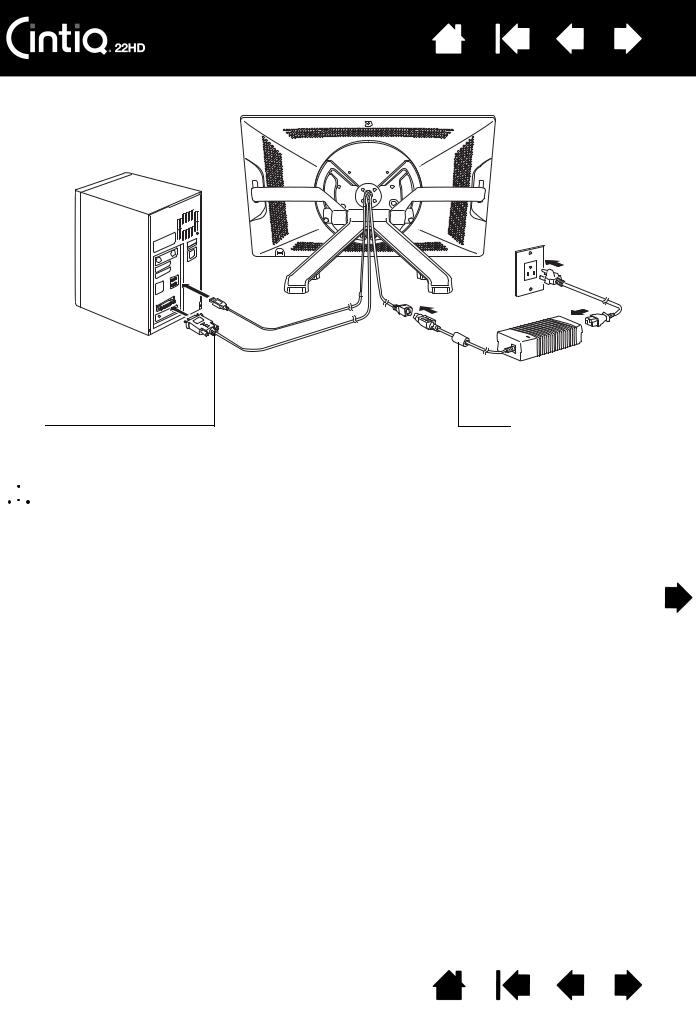
Contents Index
Cintiq cabling diagram
– B –
USB
Video card:
DVI-D, DVI-I, or VGA
– A –
Cintiq video cable with DVI-D connector, or appropriate DVI-I to VGA adapter cable
 Caution
Caution
15
AC
– D –
Power adapter
– C –
DC input.
Connect to extension cable.
Do not connect or disconnect the video or power cables while Cintiq or your computer are turned on. This can damage the display or computer video card.
Only use a power adapter specified for use with your pen display. Use of an improper power adapter may damage the pen display.
Contents Index
15

Contents Index
16
8.Turn on your computer. The interactive pen display will install as a default monitor.
9.As necessary, configure the display control panel settings for the proper size and color resolution. For best results, set Cintiq to the maximum (native) resolution of 1920x1080. See the Important Product Information guide located on the Installation CD for details about resolution sizes that can be used with Cintiq. The display size and color resolution may be constrained by the capabilities of your video card. To fine-tune, see adjusting the display.
Windows: If you are using Cintiq as a secondary display, you may first need to enable Cintiq in your display properties control panel.
After the LCD monitor portion of the installation is working to your satisfaction, move on to step 2: software installation.
Notes:
Each LCD panel is produced under very stringent quality standards. Production techniques cannot guarantee an absolutely perfect display. Wacom does not allow any pixel to be always white or always black. A small number of pixels are allowed to show a wrong color for some parts of the color spectrum. See the Important Product Information guide for more information.
If an image has fine striping (such as screen stripes), it may appear to flicker or display a moiré pattern.
Do not apply excessive pressure on the display screen surface, it may cause the appearance of a moiré or pooling pattern. If this occurs, use less pressure on the display screen when working with the pen.
When a still image is displayed for a long period of time, an after-image may remain for a short time. To prevent this, use a screen saver or other power management feature.
To extend the life of the pen display backlight, set your computer’s power management to turn off the display when not in use for extended periods of time.
Your eyes may feel more comfortable if you reduce the display screen brightness when working with Cintiq for extended periods of time. This will also extend the life of the backlight and reduce the heat felt on the display screen surface.
Some models may include a color profile on the Installation CD. To activate for use with Cintiq, first identify Cintiq as a pen display in the system display settings control panel. Then select the Cintiq profile in the color management control panel. For details, see the color management information in your operating system and application documentation.
For troubleshooting tips, see troubleshooting.
Contents Index
16

Contents Index
17
STEP 2: SOFTWARE INSTALLATION
Important: You MUST install the Wacom driver software for correct pen-on-screen functionality. Save your work and close all open applications. Temporarily disable any virus protection programs.
1.Insert the Installation CD into your computer’s CD-ROM drive. If the software installer menu does not display, double-click on the INSTALL icon located on the CD. (When available, you can also download and install the latest software driver from the Wacom web site for your region.)
2.Click INSTALL TABLET and follow the prompts to install the driver software.
3.Reactivate your virus protection program.
4.After completing the software installation, make sure you can use your pen on the Cintiq display screen to move the screen cursor.
When you place the pen tip on the display screen, the screen cursor should immediately jump to a corresponding position approximately beneath the pen tip. Lift the pen tip and place it on the display screen surface in a different location. The screen cursor should again jump to the new position. This is known as absolute positioning, and enables you to position the screen cursor without having to drag your pen across the display screen surface.
5.Check the Read Me file for updated information. Review also the Important Product Information guide located on the Installation CD for cautions and warnings. If you have trouble installing Cintiq, see troubleshooting.
6.Next, precisely align the screen cursor with the pen tip position. See calibrating the pen display.
Notes:
User-specific preferences are supported. After logging on, each user can customize their personal settings in the Wacom Tablet control panel. Switching to another user (either by logging on or fast user switching methods) will load the settings for that user.
If the pen display does not respond properly or you lose cursor control, the pen display preferences may be corrupted. See managing preferences to delete the current preference settings and return the pen display to its factory default condition.
Driver installation automatically activates the pen input functions available within Microsoft Windows 7, Vista, and Office 2007 or later (except for Windows 7 Starter and Home Basic, and Windows Vista Home Basic). See pen and digital ink capabilities in Windows.
To download a new software driver (when available) from the Internet, see obtaining software updates.
To uninstall the software driver, see uninstalling Cintiq.
Contents Index
17

Contents Index
18
GETTING TO KNOW YOUR CINTIQ
The Cintiq 22HD interactive pen display combines the benefits of a Liquid Crystal Display (LCD) with the control, comfort, and productivity of Wacom’s cordless, battery-free pen technology. This gives you a direct pen-on-screen interface for your computer.
The basic components of your Cintiq include a Wacom pen tablet internally mounted behind a high quality color display, the Wacom Grip Pen, and the Cintiq display stand.
This manual describes how to set up and use your Cintiq. The Wacom Tablet control panel enables you to customize your pen and pen display settings. To learn more, see customizing.
Note: Not all product models are available in all regions.
Pen display features
Pen features
PEN DISPLAY FEATURES
After the Cintiq pen display is safely mounted on the Cintiq stand, take some time to familiarize yourself with the features and components of your Cintiq interactive pen display. Although they will appear as separate devices to your operating system, the display and tablet sensor function as an integrated output and input device. The tablet sensor reports pen coordinates, pressure, tilt, switch, eraser, and other information.
•Many applications have built-in support for pen display features (such as pressure sensitivity,
tilt, and rotation). Visit the Wacom web site to learn about applications that support these features. See product information.
•For information on how best to use pen display features within a specific application, see the instructions in that application’s manuals.
Front view
Rear view
Contents Index
18
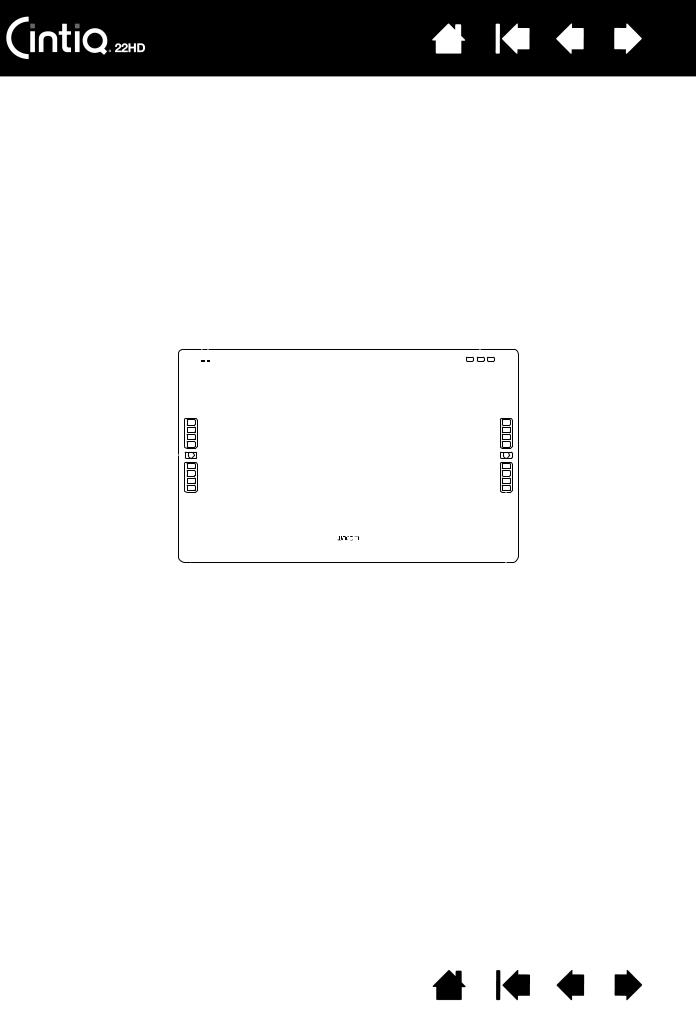
Contents |
Index |
|
19 |
FRONT VIEW
|
|
|
|
|
|
|
|
|
|
|
|
Status LED |
||||||
|
|
|
|
|
|
|
|
|
|
|
||||||||
|
|
|
|
|
|
|
|
|
|
|
|
• When using pen in active area of the pen display, lights blue when the |
||||||
|
|
|
|
|
|
|
|
|
|
|
|
pen tip, eraser, or side switch are pressed. |
||||||
|
|
|
|
|
|
|
|
|
|
|
|
• LED will not light unless the USB cable is plugged into an active USB |
||||||
|
|
|
|
|
|
|
|
|
|
|
|
port and a video signal is present. |
||||||
|
|
|
|
|
|
|
|
|
|
|
|
Power LED |
||||||
|
|
|
|
|
|
|
|
|
|
|
|
|||||||
|
|
|
|
|
|
|
|
|
|
|
|
• Lights blue when power has been supplied to Cintiq and a video signal |
||||||
|
|
|
|
|
|
|
|
|
|
|
|
is present. |
||||||
|
|
|
|
|
|
|
|
|
|
|
|
• Glows orange when no video signal is detected. (e.g., The computer is |
||||||
|
|
|
|
|
|
|
|
|
|
|
|
turned off, starting up, or has entered a power management mode in |
||||||
|
|
|
|
|
|
|
|
|
|
|
|
which video signals are not sent.) |
||||||
USB accessory port |
|
|
|
|
|
|
|
|
|
|
Hardware control buttons |
|||||||
|
|
|
|
|
|
|
|
|
|
|
||||||||
|
|
|
|
|
|
|
|
|
|
|
|
|
|
|
|
|
|
Press the right button to |
|
|
|
|
|
|
|
|
|
|
|
|
|
|
|
|
|
|
|
|
|
|
|
|
|
|
|
|
|
|
|
|
|
|
|
|
|
|
|
|
|
|
|
|
|
|
|
|
|
|
|
|
|
|
|
|
work with LCD settings |
|
|
|
|
|
|
|
|
|
|
|
|
|
|
|
|
|
||
|
|
|
|
|
|
|
|
|
|
|
|
|
|
|
|
|
|
|
|
|
|
|
|
|
|
|
|
|
|
|
|
|
|
|
|
|
using the On Screen |
|
|
|
|
|
|
|
|
|
|
|
|
|
||||||
|
|
|
|
|
|
|
|
|
|
|
|
|
|
|
|
|
|
Display (OSD). When in |
|
|
|
|
|
|
|
|
|
|
|
|
|
|
|
|
|
|
LCD settings (OSD) mode, |
|
|
|
|
|
|
|
|
|
|
|
|
|
|
|
|
|
|
the four upper right |
|
|
|
|
|
|
|
|
|
|
|
|
|
|
|
|
|
|
ExpressKeys are used for |
Touch Strip Mode |
|
|
|
|
|
|
|
|
|
|
|
|
|
adjusting the display |
||||
|
|
|
|
|
|
|
|
|
|
|
|
|||||||
One on each side. Press |
|
|
|
|
|
|
|
|
|
|
settings. |
|||||||
|
|
|
|
|
|
|
|
|
|
|
||||||||
to toggle between Touch |
|
|
|
|
|
|
|
|
|
|
|
|||||||
Strip functions. |
|
|
|
|
|
|
|
|
|
|
|
|
||||||
See pen display controls. |
|
|
|
|
|
|
|
|
|
|
|
|
||||||
See also using the |
|
|
|
|
|
|
|
|
|
|
|
|
||||||
|
|
|
|
|
|
|
|
|
||||||||||
Express View display. |
|
|
|
|
|
|
|
|
|
|
|
|
|
|
|
|||
ExpressKeys |
|
|
|
|
|
|
|
|
|
|
|
|
|
See also rear view. |
||||
|
|
|
|
|
|
|
|
|
|
|
|
|||||||
|
|
|
|
|
|
|
|
|
|
|
|
|
|
|
||||
See pen display controls. |
|
|
|
|
|
|
|
|
|
|||||||||
Contents Index
19
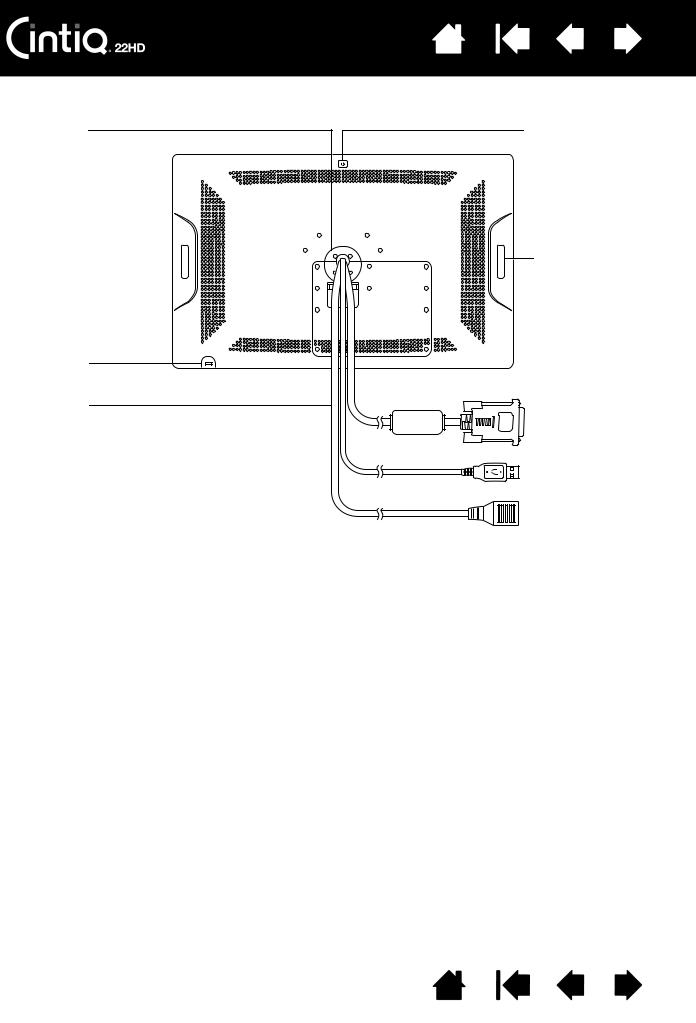
Contents Index
REAR VIEW
Bearing hub
Fits into the bearing recess on the Cintiq stand.
Allows rotation of Cintiq, and easy mounting and removal from the stand.
See also using an alternate mount or stand.
Security slot
Cabling
DVI-D, USB, and power.
20
Power button
Push to turn the pen display on or off.
Touch Strip
One on each side.
See pen display controls.
See also front view.
Important: Always store the interactive pen display on the Cintiq display stand or in its original packing carton when not in use. Do not store the pen display on a surface that would excessively bend or crimp the cables.
Next step: Review the pen features and learn about the Cintiq display stand. Then, if you have not already done so, move on to setting up your Cintiq.
Contents Index
20

Contents Index
21
PEN FEATURES
Eraser: When brought within proximity of the pen display screen, the tablet portion of the display reports the pen location. Pressure information is reported as you press down on the eraser. By default, the function is set to ERASE.
Side switch: Be sure the customizable side switch is in a convenient location where you can toggle it with your thumb or forefinger but not accidentally press it while using the pen.
You can use the switch whenever the pen tip is within proximity of the display screen. You do not need to touch the pen tip to the display surface.
Toggle the switch in either direction to activate the button functions. By default, the upper switch is set to DOUBLE CLICK and the lower switch is set to RIGHT CLICK.
Pen tip (replaceable nib): The pen activates as soon as it is brought within proximity of the pen display screen. This allows you to position the screen cursor without touching the pen tip to the display screen.
When pressure is applied to the pen tip, the pen simulates a primary mouse button click. Tip click pressure can be adjusted in the Wacom Tablet control panel.
Tips:
•The pen enters proximity when the tip or eraser is brought within 5 mm (0.2 inch) of the pen display screen surface.
•To resume operations after the pen display has entered auto sleep mode, bring the pen tip within proximity or touch the pen tip on the pen display screen.
Important:
•Use only the pen that came with your product, or a Wacom accessory pen specified for use with Cintiq. Other pens may not function properly. See available parts and accessories. Also, the Cintiq pen tip is specifically designed for use with the Cintiq pen display. The tips on other pens could damage the Cintiq display screen.
•When not in use, place the pen in the pen stand or lay it flat on your desk. To maintain the sensitivity of your pen, do not store it in a container where it will rest on the tip or eraser. Improper storage may damage pen tip pressure sensor(s).
Contents Index
21
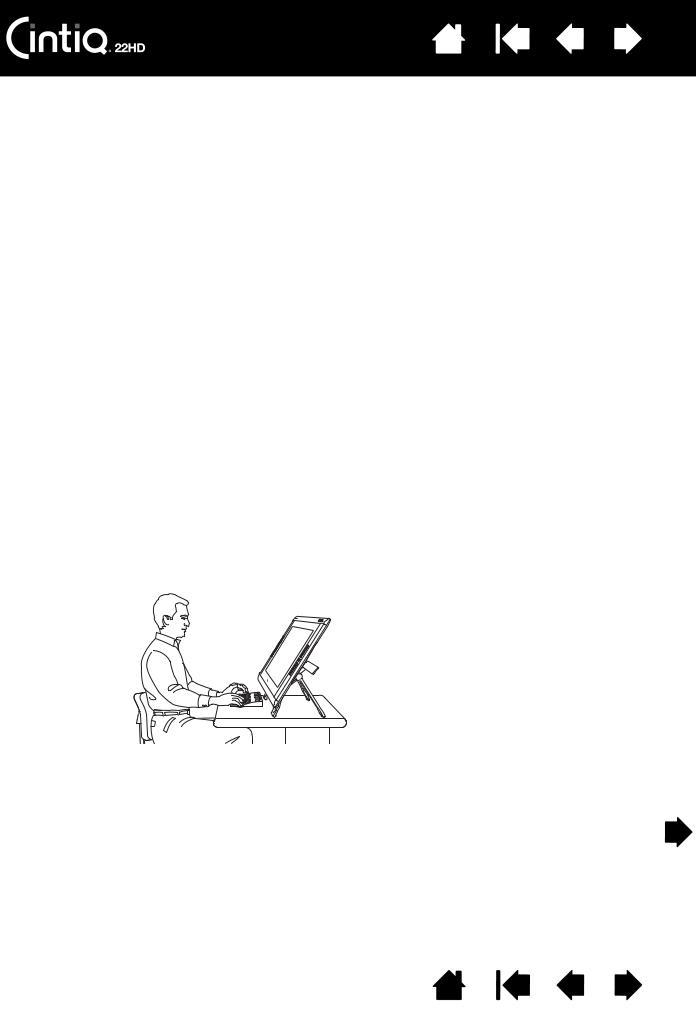
Contents Index
22
WORKING WITH YOUR CINTIQ
The Cintiq 22HD interactive pen display and Cintiq display stand were designed for a wide range of flexibility and ergonomic work approach. The design allows you to quickly adjust Cintiq to a different height and position whenever the need arises. Experiment by adjusting the display incline to determine which best fits your particular working style and tasks.
As you work with Cintiq you can rest your hand lightly on the display screen, just as if it were a drawing board or sheet of paper.
Because the Cintiq pen display surface will be a little higher than your desk, consider adjusting the height of your desk or chair to assure comfortable use of the device.
Setting up your work area
Configuring Cintiq for handedness
Using the Grip Pen
Pen display controls
Working with multiple monitors
Adjusting the display
SETTING UP YOUR WORK AREA
To minimize fatigue, organize your work area to create a comfortable environment. Position Cintiq, the pen, and your keyboard for easy access without unnecessary reaching. The pen display and any other displays should be positioned so you can view them comfortably with a minimum of eyestrain.
•If you have not already done so, be sure to configure Cintiq for your preferred handedness.
•When using Cintiq as a display, align the top of the pen display in line with the level of your eyes.
Adjust Cintiq to a position that best meets your creative needs.
•If working with a keyboard, consider locating the keyboard slightly below the desk surface in an adjustable keyboard tray.
•Maintain a good posture at all times.
Contents Index
22

Contents Index
23
•Periodically shift your gaze from your computer and focus on other objects within the room. This will help to relax your eyes.
•Use a gentle grip when working with the pen. Take short breaks between tasks to stretch and relax your muscles.
•Alternate tasks throughout the day. Minimize awkward postures and repetitive movements.
•Change your position if you feel any discomfort.
•Alternate between different modes of use. For example, every few hours adjust the Cintiq display stand to a different working position.
•Study the rest of this chapter to learn more about working with Cintiq.
•Learn about the basics of customizing Cintiq for the way you like to work.
Tips:
•Do not pull the cabling from their computer connections by accidentally moving the pen display too far from the computer.
•If the rotation lock screws are attached to the back of Cintiq, they must be removed before Cintiq can be rotated.
•Before rotating the pen display, be sure the cables are freely rotating behind the unit.
•Cintiq can also be mounted to articulated arms or other third-party stands meeting the VESA MIS-D 100/100 (4 screw) specification for monitor stands. See using an alternate mount or stand for details.
Note regarding RSI: Wacom makes no representation, promise or guarantee that Wacom products will cure or prevent, in whole or in part, mouse-induced repetitive stress symptoms, injuries or conditions. Individual results may vary. Always obtain competent medical advice to determine the most appropriate treatment for your specific situation.
Contents Index
23
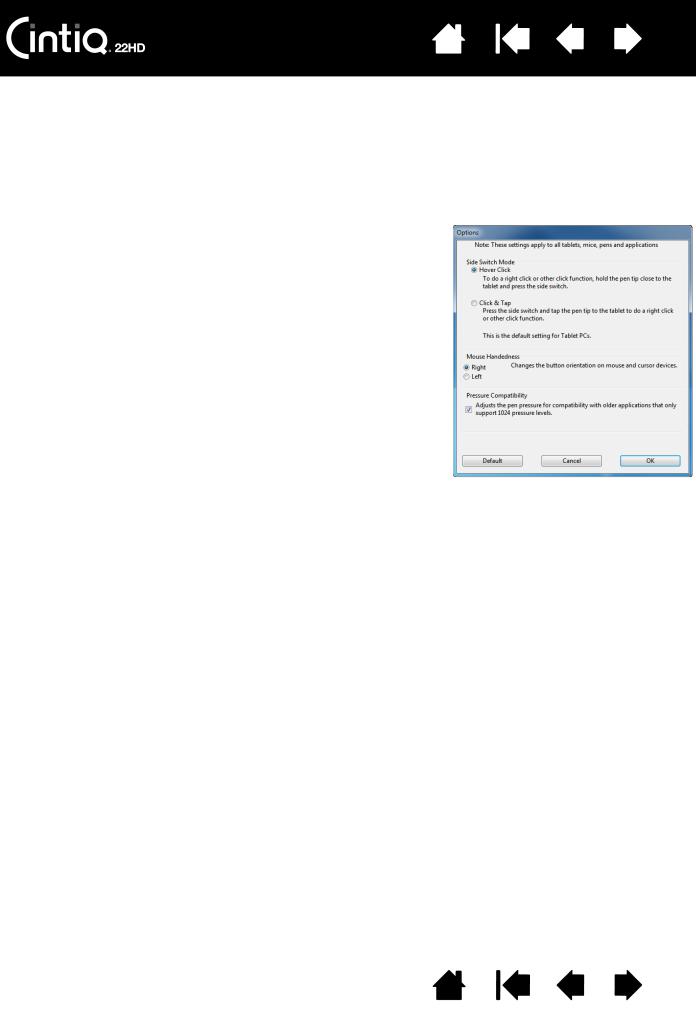
Contents Index
24
CONFIGURING CINTIQ FOR HANDEDNESS
During the installation process, you were prompted to choose a default configuration for Cintiq based on whether you are rightor left-handed. The configuration you chose was used to determine the default settings for the ExpressKeys and Touch Strips.
However, you can use the Wacom Tablet control panel to easily reconfigure Cintiq for leftor right-handed users at any time. The ExpressKey and Touch Strip settings are automatically reconfigured when you change the handedness setting.
To reconfigure for leftor right-handed users:
1.Launch the Wacom Tablet control panel by pressing the center hardware control button. Click OPTIONS....
2.Choose the appropriate setting for your preferred handedness.
3.Click OK. The existing ExpressKey and Touch Strip settings are swapped (or flipped) between left and right.
Notes:
The hardware control buttons are not affected when you change the handedness setting.
Likewise, changing the handedness setting does not affect the ExpressKeys used to control the LCD settings when in LCD settings (OSD) mode.
This procedure does not affect the default orientation. At the system log on and user switching screens, the pen display uses the default configuration you chose during the install process. To change the default configuration, you must re-install the Wacom driver.
USING THE GRIP PEN
The cordless, battery-free pen senses the amount of pressure and tilt you apply to the tip. There are four basic techniques for using the pen: pointing, clicking, double-clicking, and dragging. If you are unfamiliar with using the pen, see the following pages.
Holding the pen
Positioning
Clicking
Dragging
Using the side switch
Working with pressure sensitivity
Drawing with tilt
Erasing
Contents Index
24
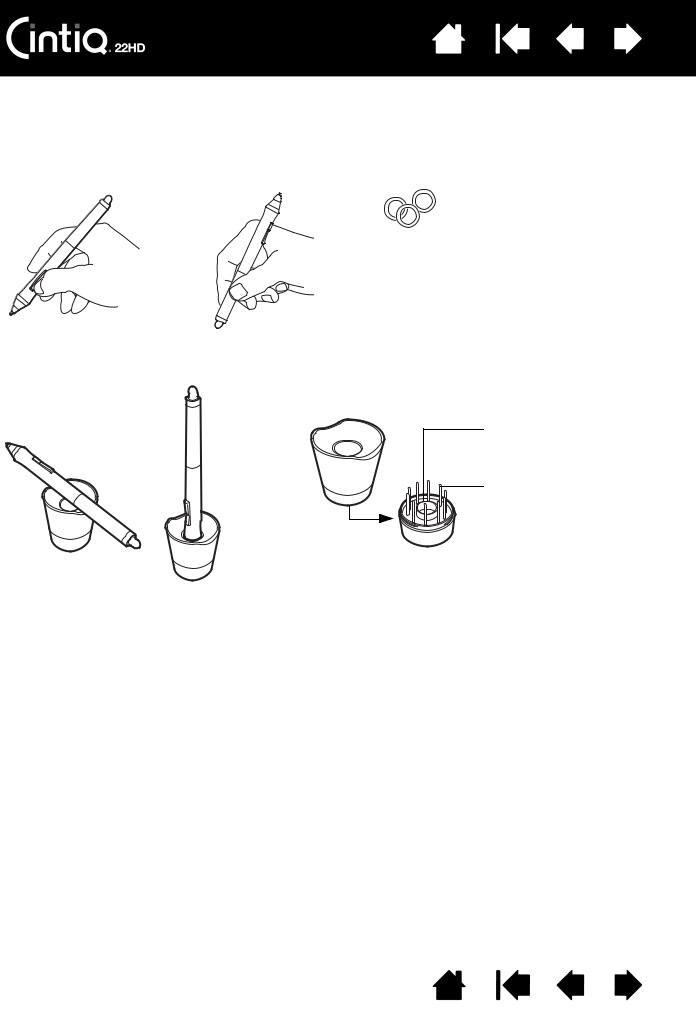
Contents Index
25
HOLDING THE PEN
Hold the pen like you would a normal pen or pencil. Adjust your grip so that the side switch is in a convenient location where you can toggle it with your thumb or forefinger. Be careful not to accidentally press the switch while drawing or positioning with the pen. Tilt the pen in any way that feels most comfortable. As you work with Cintiq you can rest your hand lightly on the display screen.
If you are working in a multi-user environment or otherwise want to personalize your pen, unscrew the tip cone and replace the colored ring with one of another color (included).
You can customize the pen settings at any time.
Place the pen stand within easy reach. When not in use, place the pen in the pen stand or lay it flat on your desk. The stand allows for vertical or horizontal placement of the pen.
Unscrew the base of the pen stand to access a nib removal tool and assorted replacement nibs.
Nib removal tool
Replacement nibs
• 6 standard nibs
• 3 hard felt nibs
• 1 stroke nib
Important: To maintain the sensitivity of your pen, do not store it in a container where it will rest on the tip or eraser. Improper storage may damage the pen tip pressure sensor(s).
Contents Index
25

Contents Index
26
POSITIONING
To position the screen cursor, move the pen slightly above the Cintiq display screen without touching the screen surface. Press the pen tip on the display screen to make a selection.
Note: Calibrating the pen display ensures correct alignment of the screen cursor with the pen tip. If the screen cursor does not jump to a position near the pen tip when you place the pen on the display screen, then the pen display software driver may not be installed or is not loading. Install the driver software if necessary. Otherwise, see troubleshooting.
CLICKING
Tap the display screen once with the pen tip, or touch the pen to the display screen with enough pressure to register a click.
Tip: Configure Windows to select when hovering the pen over an icon and to launch the icon with a single click. To turn on this feature, first open a folder.
Windows 7 and Vista: From the ORGANIZE pull-down menu
choose FOLDER AND SEARCH OPTIONS. From the GENERAL tab select SINGLE-CLICK TO OPEN AN ITEM (POINT TO SELECT).
Windows XP: From the TOOLS pull-down menu choose
FOLDER OPTIONS.... From the GENERAL tab select SINGLE-
CLICK TO OPEN AN ITEM (POINT TO SELECT).
Press the upper side switch (when set to DOUBLE CLICK), or quickly tap the display screen twice in the same place with the pen tip. Double-clicking is easier when using the pen perpendicular to the pen display screen.
Contents Index
26

Contents Index
27
DRAGGING
Select an object, then slide the pen tip across the display screen to move the object.
USING THE SIDE SWITCH
The pen comes equipped with a side switch. This switch has two customizable functions that can be selected by rocking the switch in either direction. You can use the side switch whenever the pen tip is within proximity (5 mm (0.2 inch)) of the display screen surface. You do not need to touch the pen tip to the display surface in order to use the switch. By default, the upper switch is set to DOUBLE CLICK, and the lower switch is set to RIGHT CLICK. You can customize or disable the switch functions using the Wacom Tablet control panel.
WORKING WITH PRESSURE SENSITIVITY
The pen responds to the nuance and inflection of your hand movements, enabling you to create naturallooking pen and brush strokes within applications that support this feature.
To draw, ink, or write with pressure sensitivity, move the pen along the display screen surface while applying various amounts of pressure downward on the tip of the pen. Press hard for thick lines or dense color. Press gently for thin lines or softer color. Some applications require that you first select a pressuresensitive tool from the application tool palette.
To adjust tip feel, see adjusting tip feel and double-click.
Visit the Wacom web site to learn about applications that support pressure. See product information.
Contents Index
27

Contents Index
28
DRAWING WITH TILT
The pen display recognizes when you tilt the pen from vertical to incline positions. Tilt can be used to control line shape and thickness in supporting applications.
Visit the Wacom web site to learn about applications that support tilt. See product information.
ERASING
In supporting applications the pen eraser works like the eraser on a pencil. In text applications, use the eraser to select text and then lift the eraser from the pen display screen to delete the text.
Visit the Wacom web site to learn about applications that support the eraser. See product information. If the eraser is not supported in an application, you can still use the eraser for positioning, drawing, or annotation.
Contents Index
28
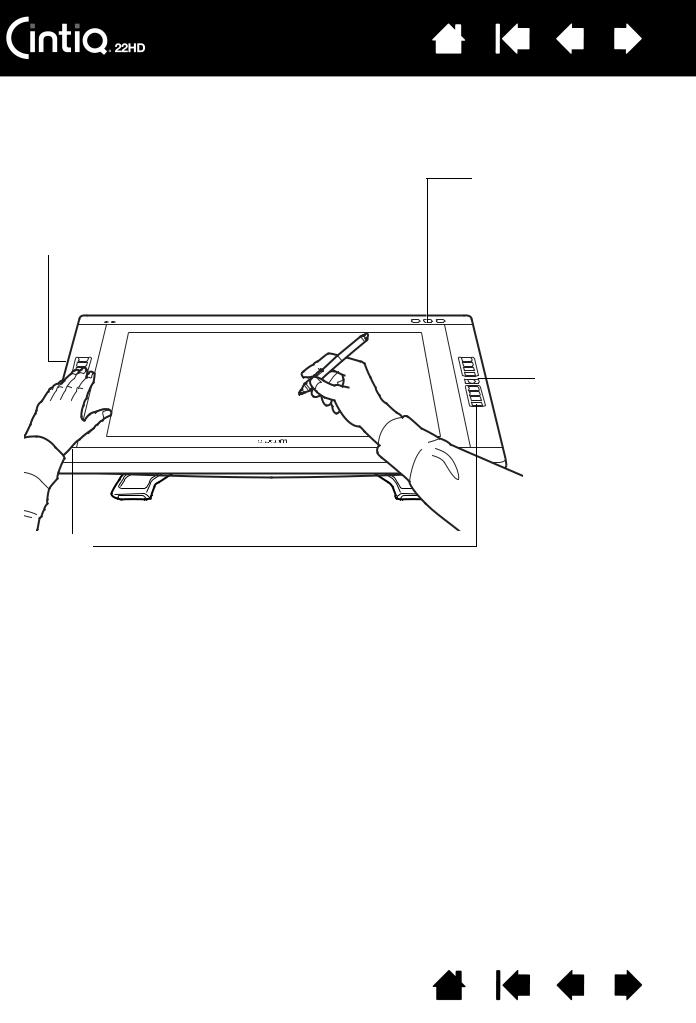
Contents Index
29
PEN DISPLAY CONTROLS
To improve your workflow in graphics or other applications, Cintiq features ExpressKeys and Touch Strips. While using the pen with your dominant hand, you can simultaneously use your other hand to operate the ExpressKeys or Touch Strip.
Touch Strips
Located on back of pen display, one on each side.
Slide your finger over the Touch Strip to zoom, scroll, or issue assigned keystroke actions. See using the Touch Strips.
Hardware control buttons
Press a button to activate the assigned function. See using the hardware control buttons.
Touch Strip Mode
Press to toggle between Touch Strip functions. The left button toggles the left Touch Strip functions, and the right button toggles the right Touch Strip.
ExpressKeys |
Each time you press a Touch Strip Mode button, an overlay appears briefly on your display screen to show the function assignments.
See also using the Express View display.
Press the customizable keys to perform frequently used functions or keystrokes, or to emulate button clicks or modifier keys. See using the ExpressKeys.
A Display Toggle function is available for use on multiple monitor systems. This feature enables you to toggle the screen cursor between Cintiq and your other displays. For example: Cintiq can be used as a pen display where the cursor is positioned at the pen tip location, or toggled for use as a standard Wacom tablet where the cursor can be moved across the entire desktop or any display on your system.
Contents Index
29
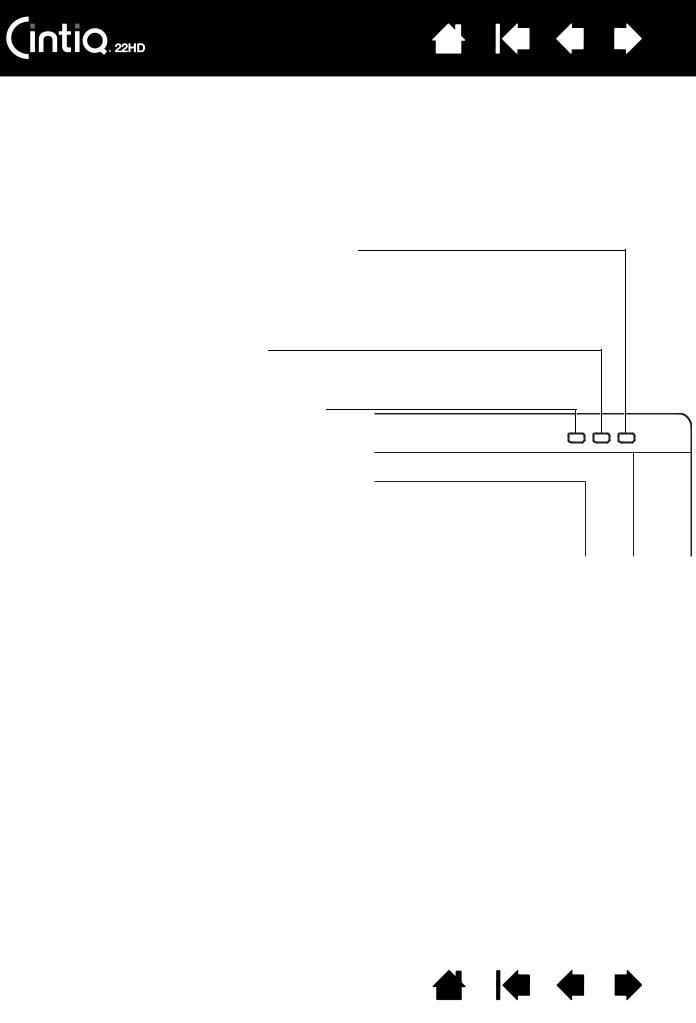
Contents Index
30
USING THE HARDWARE CONTROL BUTTONS
Press a button to:
•Display a diagram of your current Cintiq settings.
•Launch the Wacom Tablet control panel.
•Work with LCD settings using the On Screen Display (OSD).
Press the button again to toggle off the function.
Toggles the four upper right ExpressKeys between normal operation and the LCD settings (On Screen Display) mode.
In LCD settings (OSD) mode, the OSD menu is activated on your display screen and the upper right ExpressKeys are used for adjusting the display. Press to toggle back to ExpressKeys mode.
Launches the Wacom Tablet control panel.
Press to close the control panel when open.
Shows (on your display screen) a diagram of the pen display ExpressKey, Touch Strip, and pen settings.
The current functions for each control are shown.
Press to dismiss the diagram.
Notes:
You may notice a slight delay in response time, depending on the speed of your computer. The control buttons cannot be customized.
Contents Index
30
